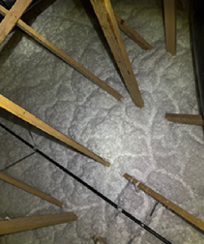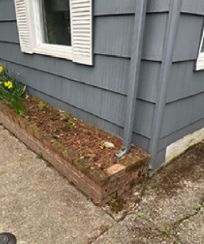We live in a region that is blessed with beautiful forests, spectacular wilderness, and natural areas. With that, we are host to a variety of rodents, ants, beetles, and even termites. All of these pests are a potential problem for our homes. Rodents can cause damage to insulation and electrical systems, and their droppings and carcasses can create a health hazard. These may necessitate professional pest control services to mitigate, clean, and repair damaged areas.
Additionally, wood-destroying organisms found in our region (such as ants, beetles, and termites) can cause structural damage to a home long before they are noticed. To effectively prevent pest damage to the home, we must educate ourselves on the conditions that can attract pests. Prevention is the most effective method of protection.
Let’s start by covering some of the most common red flags.
- Damaged ventilation screens
- Gaps in exterior access to crawlspaces
- Vegetation in contact with the home’s structure
- Falling insulation in the crawlspace
- Trails through the insulation in the attic
- Rodent droppings
- Moisture damage to wood and wood products
Where are pests typically found in the home?
Insects such as ants, beetles, and termites are usually found in damp areas that contain moist wood products (wood and wood products are often used in homes as siding, decking, subfloor, floor joists, posts, and beams). Moisture in these can be caused by the following: soil covering wood products, vegetation surrounding wood products, ventilation lines (such as dryer vents) discharging onto wood products, or plumbing and roof leaks that drip onto and moisten wood products.
To find rodent activity in your home, check hidden spaces like the attic, basement, crawlspace, or garage. Other common places to look are on top of your furnace and water heater. Rodents tend to like the warmth there.
Preventing pest problems
Depending on the pest activity you’re dealing with, there are different remedies to keep pests where they belong, outside of your home. Below we’ll cover pest prevention tips for wood-destroying organisms and rodents.
Wood-destroying organism prevention tips
- Regularly practice general home maintenance.
- Remove soil in contact with wood products around your home (this might be the most common scenario attracting wood-destroying insects).
- Clear away soil and debris from the foundation wall around the entire home perimeter so you can see approximately four to six inches of the concrete foundation wall all the way around.
- Trim trees and remove any vegetation in contact with the home. Although pest control professionals spray pesticides at the base of a structure, ants are smart and will use trees or bushes in contact with the home as a bridge to get inside your home.
- Enter the crawlspace and remove all excess wood and cellulose debris – insects consider this a food source.
- Ensure your plastic vapor barrier is not damaged and covers all the soil in your crawlspace.
- Inspect plumbing and roof for leaks and moisture intrusion. Dampened wood from leaks can attract insects.
Rodent prevention tips
- Ensure all ventilation screens are not damaged. (e.g. foundation vents and soffit vents)
- If your home has exterior access to the crawlspace, inspect it carefully for gaps. Rodents can easily squeeze through holes the size of a dime!
- As mentioned above, trim trees and remove any vegetation in contact with the home to prevent pest activity.
- If your furnace is located in the garage, look for any gaps behind it that lead to the crawlspace.
- Rodents can and will get into your garage. Garage doors are often left open and are not rodent-proof when closed, so always keep an eye out.
- Keep your household pet food indoors. Rodents love snacking on your cat or dog’s dry kibble.
- Enter your crawlspace and look for daylight gaps, then screen any that are found. To see if you have any daylight gaps, turn off your flashlight and sit in the dark. Let your eyes adjust, and look for daylight coming into the crawlspace.
- Small holes and gaps can be sealed with a combination of brass wool followed by a spray of expanding foam. Brass wool is preferred over steel wool here because it doesn’t rust.
- Avoid using outdoor feeders for wildlife.

Rodent trails through the insulation of an attic

Falling insulation

Rodent droppings

Vegetation in contact with the home's structure
What homeowners don’t know about pest prevention
Many homeowners don’t realize that you can prevent pest problems by following a home maintenance routine each year in the fall and spring. If you encounter pests in the home, the remediation can range from fairly simple to difficult and costly. Insect activity can be corrected by repairing the moisture-related issues, leaving nothing for the insects to feed on. They will typically move out to a new location that has a good food source. Dealing with a rodent infestation can be especially difficult. The key is to locate their entry points and properly seal those gaps. Sometimes this is best done by a professional pest control company. Once you are assured that all gaps are closed and the remaining rodents are exterminated, any repairs from rodent damage can begin.
Do greenbelts increase rodent activity?
Another misconception homeowners have about pests is that greenbelts and natural areas increase the chances of rodent activity in the home. This isn’t necessarily true, as rodents roam throughout both rural and urban areas. They can be found in dense cities, quaint suburbs, and homes on acres of land. Rodents will always be outside, no matter where your home is located. The key factor in preventing rodent activity is ensuring your home is properly protected from intrusion.
If you’re unfamiliar with the term greenbelt, it’s when a local jurisdiction requires a section of land in a community to be preserved in its natural habitat.
Prevent pest problems with home inspections
Pests, especially rodents, are such a common occurrence that checking your home for pest activity before purchasing is imperative. Even a newly built home can have rodent activity. For example, if a foundation screen is damaged during construction, it leaves an easy route for rodents to enter. Unlike many home inspectors in our region, Zoom Home Inspections is licensed to provide structural pest inspections, and we do it along with every standard home inspection at no additional fee.
We hope this information helps answer common concerns for managing and mitigating pests around your home.
To schedule a home inspection with Zoom, click here or contact us at (425) 301-2747 if you’d like to speak with us prior to the appointment.

